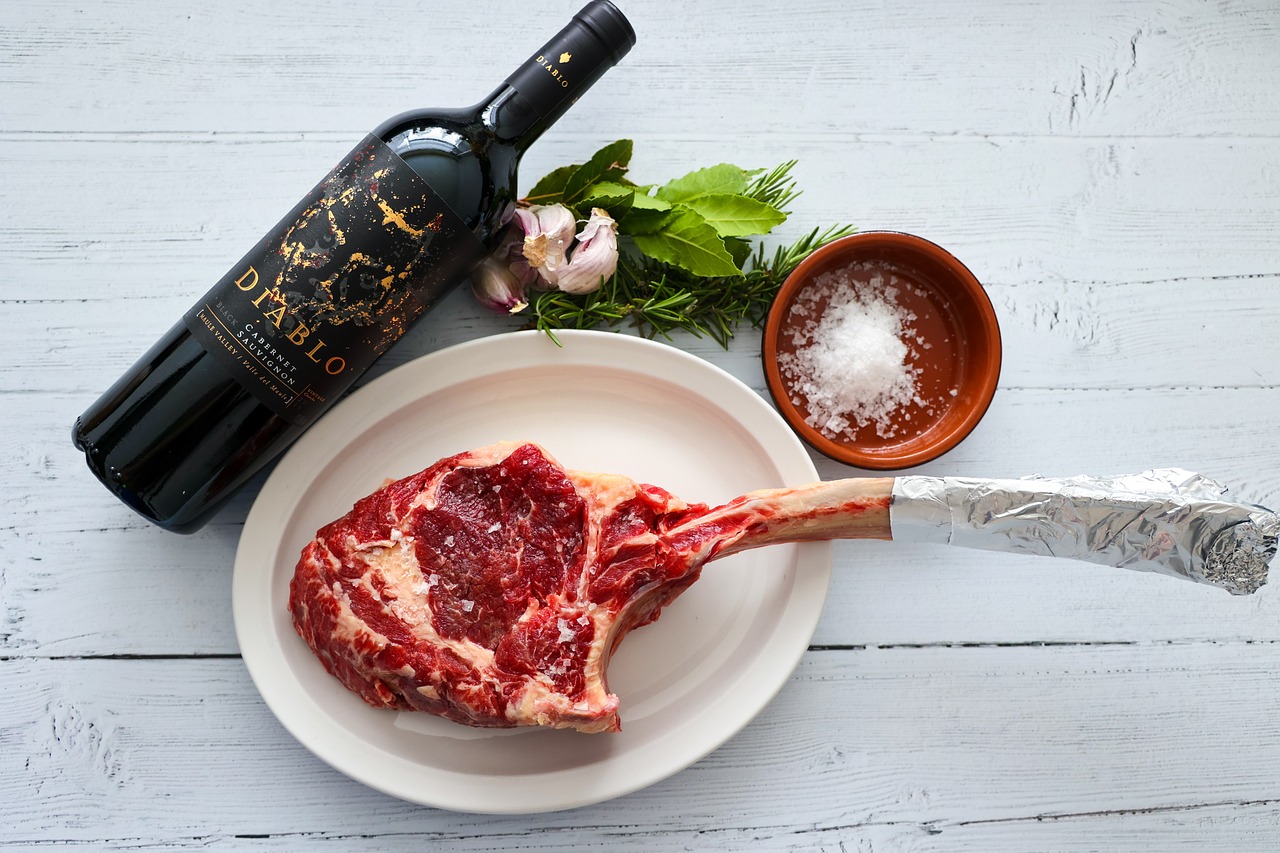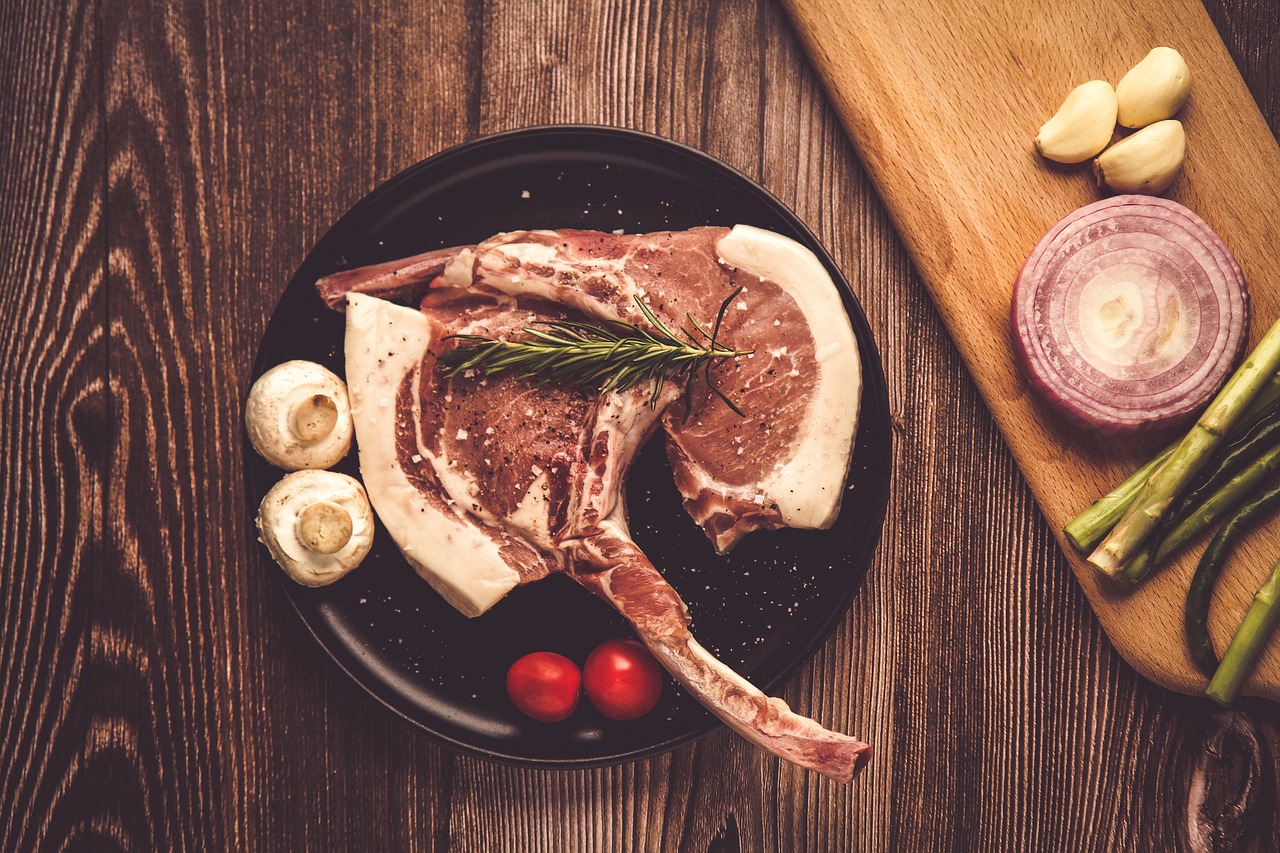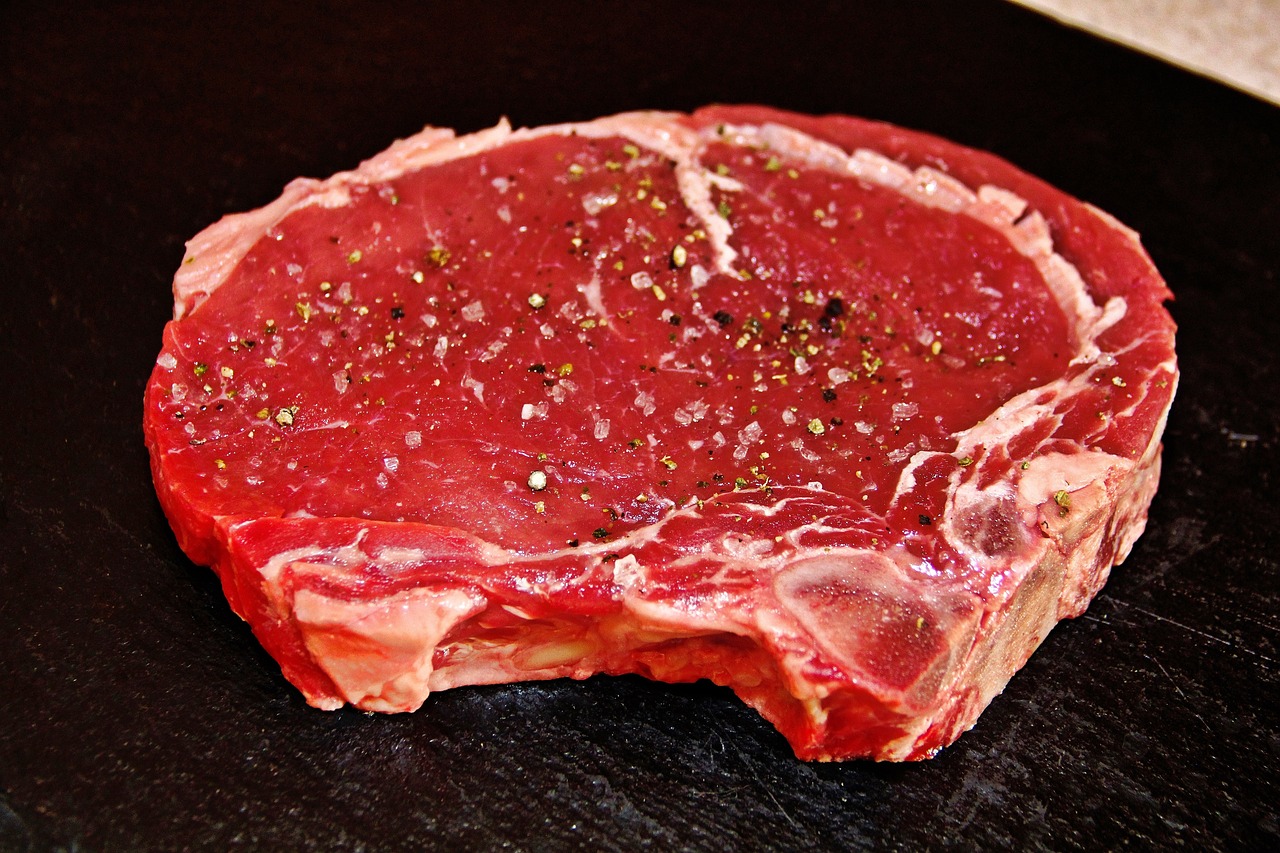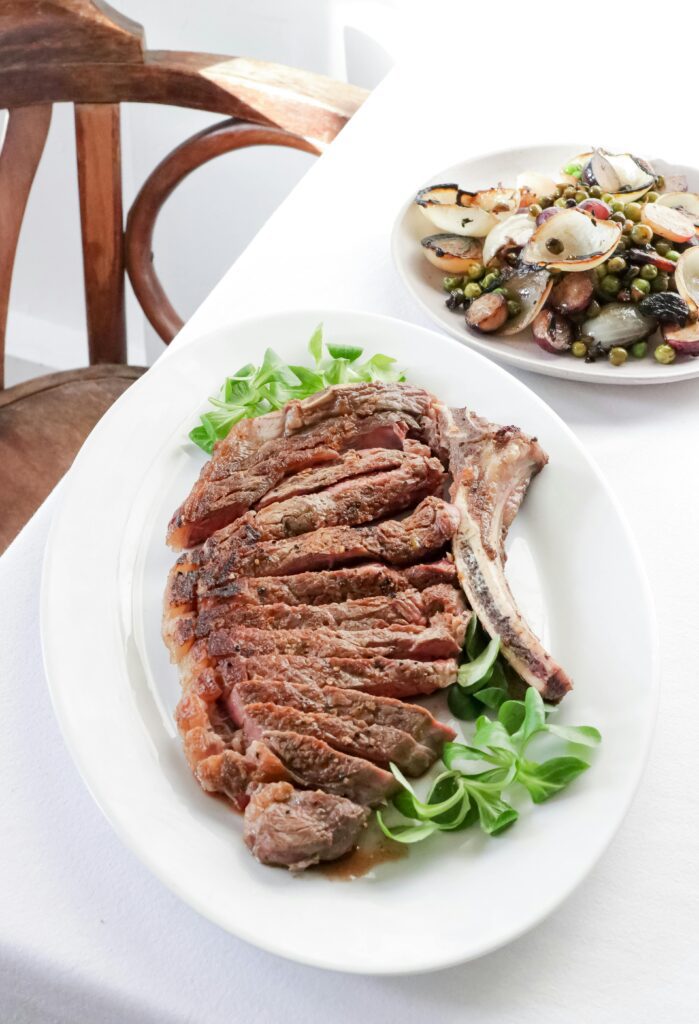Introduction to Tomahawk vs Ribeye
The Tomahawk and Ribeye cuts are two popular choices among steak connoisseurs. Both cuts are known for their tenderness and rich flavor, but they have some key differences. In this article, we will explore the differences between these two cuts and provide some factors to consider when choosing a steak.
Introduction to the Tomahawk and Ribeye cuts
The Tomahawk cut is essentially a Ribeye steak with the bone left intact, resembling a tomahawk axe. This thick-cut steak is known for its impressive presentation and is often considered a showstopper at special occasions. The bone of the Tomahawk steak contributes to its unique appearance and can also add flavor to the meat.
On the other hand, the Ribeye cut is a boneless steak that is known for its marbling, which refers to the intramuscular fat that runs through the meat. This marbling gives the Ribeye its juicy and flavorful taste, making it a favorite among steak lovers.
Factors to consider when choosing a steak
- Flavor: Both the Tomahawk and Ribeye cuts offer rich and intense flavors. The Tomahawk steak may have a slightly stronger taste due to the presence of the bone, while the Ribeye cut is known for its buttery and melt-in-your-mouth texture.
- Size: The Tomahawk steak is usually larger in size compared to the Ribeye cut. This means that if you have a big appetite or are planning to serve multiple people, the Tomahawk might be the better choice.
- Presentation: If you’re looking to make a statement at your meal, the Tomahawk steak is sure to impress with its striking appearance. However, the Ribeye cut still offers a delicious and visually appealing dish without the added bone.
- Price: The Tomahawk cut is often priced higher than the Ribeye due to its size and unique presentation. If you’re on a budget, the Ribeye cut can be a more cost-effective option without compromising on taste.
In conclusion, the choice between a Tomahawk and Ribeye cut ultimately comes down to personal preference. Both cuts offer incredible flavor and tenderness, but the Tomahawk may appeal to those who are looking for a beautiful and substantial steak, while the Ribeye is perfect for those who prefer a boneless, marbled masterpiece.
Tomahawk Steak
Overview and characteristics of the Tomahawk steak
The Tomahawk steak is a popular choice among steak connoisseurs due to its impressive presentation and unique flavor. It is essentially a Ribeye cut with the bone left intact, resembling a tomahawk axe. The bone of the Tomahawk steak adds to its visual appeal and can also provide additional flavor to the meat.
Cooking methods for the Tomahawk steak
When it comes to cooking the Tomahawk steak, there are a few key methods to consider:
- Grilling: Grilling the Tomahawk steak over an open flame can enhance its smoky flavor and develop a delicious char on the outside. Due to its bone-in nature, cooking times may vary, so it’s crucial to monitor the internal temperature with a meat thermometer for desired doneness.
- Oven roasting: Preheat the oven to a high temperature and then transfer the Tomahawk steak onto a roasting rack to achieve a crispy crust while ensuring even cooking. It’s recommended to sear the steak on the stovetop before transferring it to the oven.
- Sous vide: Sous vide cooking involves sealing the steak in a vacuum-sealed bag and cooking it in a water bath at a precise temperature. This method results in consistently cooked Tomahawk steaks with a tender texture, ensuring an enjoyable dining experience.
The cooking method chosen will depend on personal preference and availability of cooking equipment. Regardless of the chosen cooking method, it’s important to let the Tomahawk steak rest before slicing into it, allowing the juices to redistribute and ensuring maximum tenderness.
In conclusion, the Tomahawk steak offers a visually impressive and flavorful dining experience for steak enthusiasts. With various cooking methods to choose from, each yielding their own unique results, it’s possible to enjoy this show-stopper of a steak with preferred flavor and texture.



Tomahawk Steak Flavor and Texture
Flavor profile and marbling of the Tomahawk steak
The Tomahawk steak is known for its rich and intense flavor. It is derived from the Ribeye cut, which is already praised for its well-marbled meat. The marbling, which refers to the intramuscular fat throughout the steak, adds a distinct richness and juiciness to the meat. This marbling also contributes to the steak’s flavor by ensuring that each bite is tender and flavorful. Additionally, the bone-in nature of the Tomahawk steak can further enhance its flavor profile, as the bone can infuse additional savory and smoky notes into the meat during cooking.
Texture and tenderness of the Tomahawk steak
The Tomahawk steak boasts a tender and melt-in-your-mouth texture. The marbled fat within the meat helps to keep it moist and succulent during cooking, resulting in a buttery and tender bite. The bone left intact also adds to the texture of the steak, giving it a firm and satisfying chew. Due to its thickness and bone-in nature, the Tomahawk steak may take longer to cook compared to other cuts of steak. However, with the right cooking method and temperature control, it can be cooked to perfection, maintaining its tender texture throughout.
Whether grilled, oven roasted, or cooked sous vide, the Tomahawk steak offers an impressive flavor and texture experience. The combination of its well-marbled meat, bone-in presentation, and careful cooking techniques result in a steak that is both visually stunning and incredibly delicious. Steak enthusiasts can choose their preferred cooking method to suit their taste preferences and cooking equipment. Regardless of the method chosen, it is important to let the Tomahawk steak rest after cooking, as this allows the juices to redistribute and results in maximum tenderness.



Ribeye Steak
Overview and characteristics of the Ribeye steak
The Ribeye steak is widely regarded as one of the most flavorful cuts of beef. It is highly prized for its abundant marbling, which gives it a rich and intense taste. The marbling consists of intramuscular fat that runs throughout the steak, providing both flavor and juiciness. The Ribeye comes from the rib section of the cow, where it benefits from being close to the bone, further enhancing its flavor profile.
In terms of texture, the Ribeye steak is known for its tenderness and succulence. The marbled fat within the meat keeps it moist while cooking, resulting in a buttery and melt-in-your-mouth experience. The absence of any connective tissue or excessive fat means that the Ribeye offers a tender chew and easy slicing.
Cooking methods for the Ribeye steak
The Ribeye steak can be cooked using various methods, depending on personal preference and equipment available. Some popular cooking methods include:
- Grilling: Grilling the Ribeye steak over high heat is a classic and flavorful way to prepare this cut. The searing heat helps to develop a caramelized crust while retaining the juicy interior. It is important to monitor the steak closely to prevent overcooking and to achieve the desired level of doneness.
- Pan-searing: Pan-searing is a versatile cooking method that allows for precise control over the cooking process. Start by searing the steak on a hot skillet to create a crispy exterior, then finish cooking it in the oven to reach the desired internal temperature. This method is ideal for achieving a perfect medium-rare or medium steak.
- Sous vide: Sous vide cooking involves vacuum-sealing the steak in a bag and cooking it in a water bath at a controlled temperature for an extended period. This method ensures even cooking and maximum retention of juices, resulting in a perfectly cooked and tender Ribeye.
Regardless of the cooking method chosen, it is important to allow the Ribeye steak to rest for a few minutes after cooking. This allows the juices to distribute evenly throughout the meat, resulting in a more tender and flavorful steak.
In conclusion, the Ribeye steak offers a combination of exceptional flavor and tenderness. Its marbling and proximity to the bone contribute to its rich taste, while its texture is renowned for being tender and juicy. Whether grilled, pan-seared, or cooked sous vide, the Ribeye steak is sure to satisfy steak lovers with its unmatched taste and quality.



Ribeye Steak Flavor and Texture
Flavor profile and marbling of the Ribeye steak
The Ribeye steak is known for its exceptional flavor profile, making it a favorite among beef enthusiasts. This cut is highly regarded for its abundant marbling, which refers to the intramuscular fat that runs throughout the steak. The marbling not only enhances the flavor but also adds juiciness to the meat. Being derived from the rib section of the cow, the Ribeye benefits from being close to the bone, further intensifying its taste.
Texture and tenderness of the Ribeye steak
The Ribeye steak is renowned for its tenderness and succulence, providing a delightful eating experience. The marbled fat within the meat maintains its moisture during cooking, resulting in a buttery and melt-in-your-mouth sensation. This cut lacks excessive connective tissue and fat, allowing for a tender chew and easy slicing.
When cooking the Ribeye steak, there are several popular methods to choose from:
- Grilling: Grilling the Ribeye steak over high heat is a classic and flavorful option. The searing heat creates a caramelized crust while preserving the juiciness of the interior. It’s crucial to monitor the steak closely to avoid overcooking and achieve the desired level of doneness.
- Pan-searing: Pan-searing offers precise control over the cooking process. Start by searing the steak on a hot skillet to achieve a crispy exterior, then finish cooking it in the oven to reach the desired internal temperature. This method is ideal for achieving a perfect medium-rare or medium steak.
- Sous vide: Sous vide cooking involves vacuum-sealing the Ribeye steak and cooking it in a water bath at a controlled temperature for an extended period. This method ensures even cooking and maximum retention of juices, resulting in a perfectly cooked and tender steak.
Regardless of the chosen cooking method, it is important to allow the Ribeye steak to rest for a few minutes after cooking. This allows the juices to distribute evenly throughout the meat, further enhancing its tenderness and flavor.
In conclusion, the Ribeye steak offers an exceptional combination of flavor and tenderness. Its marbling and proximity to the bone contribute to its rich taste, while its texture is renowned for being tender and juicy. Whether grilled, pan-seared, or cooked sous vide, the Ribeye steak is sure to satisfy steak lovers with its unmatched taste and quality.



Tomahawk vs Ribeye: Differences in Preparation
Different preparation techniques for Tomahawk and Ribeye steaks
The Tomahawk steak and Ribeye steak have distinct characteristics that require different preparation techniques to bring out their best flavors and textures.
When it comes to grilling, the Tomahawk steak requires some additional steps compared to the Ribeye. Due to its large bone and thickness, it is recommended to use indirect grilling for the Tomahawk steak. This involves searing the steak over direct heat to develop a flavorful crust and then moving it to indirect heat to finish cooking. This method ensures that the bone is cooked properly and adds depth of flavor to the steak. On the other hand, the Ribeye steak can be grilled directly over high heat for a shorter duration due to its smaller size and boneless nature.
In terms of pan-searing, both steaks can be cooked using this method, but there are some differences in the technique. The Tomahawk steak may require additional cooking time to ensure that it is evenly cooked throughout due to its thickness. It is recommended to use a combination of searing on a hot skillet and finishing in the oven for this cut. On the other hand, the Ribeye steak can be pan-seared in a hot skillet for a shorter duration, as it cooks faster compared to the Tomahawk.
Grilling vs pan-searing
Grilling and pan-searing are two popular methods of cooking steaks, each offering their unique advantages:
- Grilling: This method imparts a smoky flavor to the steak and creates a caramelized crust. It is ideal for achieving a charred exterior while keeping the interior juicy and tender. Grilling is a great option for those who prefer a more traditional and outdoor cooking experience.
- Pan-searing: Pan-searing provides more control over the cooking process and allows for precise temperature management. This method is excellent for achieving a crispy crust while ensuring even cooking throughout the steak. Pan-searing is a suitable choice for those who prefer indoor cooking or have limited outdoor grilling options.
In conclusion, while both the Tomahawk and Ribeye steaks offer exceptional flavors and textures, they require different preparation techniques due to their unique characteristics. Whether grilling or pan-searing, understanding the nuances of each cut will help you create a delicious and perfectly cooked steak.



Tomahawk vs Ribeye: Taste Test
Taste comparison between Tomahawk and Ribeye steaks
The Tomahawk steak and Ribeye steak both offer incredible flavors, but they do have some differences that can affect the overall taste experience. Let’s compare these two steaks:
Factors that affect the taste and enjoyment of each steak
1. Marbling: The level of marbling, or fat distribution within the meat, plays a significant role in the taste of both steaks. The Ribeye steak is known for its generous marbling, which adds richness and juiciness to the meat. On the other hand, the Tomahawk steak usually has less marbling but compensates with its large bone, which adds flavor during the cooking process.
- Texture: The texture of the two steaks also differs. The Ribeye steak is known for its tenderness, as the marbling helps to keep it moist and juicy. The Tomahawk steak, while still tender, has a slightly firmer texture due to its lower fat content and larger size. However, this steak offers a more robust bite and a satisfying chew.
- Flavor: The flavor profile of the Ribeye steak is often described as rich and buttery, thanks to the marbling and beefy taste. The Tomahawk steak, on the other hand, has a more intense flavor due to its bone-in nature. The bone adds depth and complexity to the meat, resulting in a more savory and robust taste.
- Cooking method: The preparation method can also affect the taste of both steaks. The Tomahawk steak, due to its thickness and bone, benefits from indirect grilling or a combination of searing and oven-finishing to ensure proper cooking and flavor development. The Ribeye steak, being smaller and boneless, can be grilled or pan-seared quickly for a shorter duration.
In conclusion, the taste experience of the Tomahawk and Ribeye steaks can differ due to factors such as marbling, texture, flavor, and cooking methods. Both steaks offer delicious flavors and can be enjoyed in different ways depending on personal preference and cooking techniques.



Tomahawk vs Ribeye: Which is Better?
Comparison of flavor, tenderness, and overall experience between Tomahawk and Ribeye
When it comes to comparing the taste, tenderness, and overall experience of Tomahawk and Ribeye steaks, there are several factors to consider. Let’s take a closer look at these two popular cuts of beef:
- Flavor: The Ribeye steak is known for its rich and buttery flavor, thanks to its generous marbling. The fat distribution within the meat adds juiciness and enhances the beefy taste. On the other hand, the Tomahawk steak offers a more intense and robust flavor due to its bone-in nature. The bone adds depth and complexity to the meat, resulting in a savory and satisfying taste.
- Tenderness: The Ribeye steak is widely praised for its tender texture, as the marbling helps to keep it moist and juicy during cooking. On the other hand, the Tomahawk steak, while still tender, has a slightly firmer texture due to its lower fat content and larger size. However, many steak enthusiasts enjoy the firmness of the Tomahawk steak as it offers a more substantial bite and a satisfying chew.
- Cooking methods: The Tomahawk steak, with its thickness and bone, benefits from indirect grilling or a combination of searing and oven-finishing. This allows for proper cooking and flavor development. On the other hand, the smaller and boneless Ribeye steak can be quickly grilled or pan-seared for a shorter duration.
Personal preferences and recommendations
Ultimately, the choice between Tomahawk and Ribeye steaks comes down to personal preference. If you prefer a buttery and tender steak with a rich flavor, the Ribeye is a great option. However, if you enjoy a more intense and robust flavor with a substantial bite, the Tomahawk might be the better choice for you.
It’s also worth considering the occasion and cooking techniques. If you’re looking to impress guests at a dinner party, the Tomahawk steak’s impressive presentation and flavor can make a statement. On the other hand, the Ribeye steak’s tenderness and ease of cooking make it a reliable choice for a weeknight meal.
In the end, both the Tomahawk and Ribeye steaks offer incredible flavors and can be enjoyed in different ways depending on personal preference and cooking techniques. So, whether you choose the Tomahawk or the Ribeye, you’re sure to have a delicious steak experience.
Summary and final thoughts on the Tomahawk vs Ribeye steak showdown
When comparing the Tomahawk and Ribeye steaks, there are several factors to consider in terms of flavor, tenderness, and overall experience.
- The Ribeye steak offers a rich and buttery flavor, thanks to its generous marbling. The fat within the meat adds juiciness and enhances the beefy taste.
- The Tomahawk steak, on the other hand, delivers a more intense and robust flavor, owing to its bone-in nature. The bone adds depth and complexity to the meat, resulting in a savory and satisfying taste.
- In terms of tenderness, the Ribeye is widely praised for its moist and juicy texture. The marbling helps keep the meat tender throughout cooking.
- The Tomahawk, while still tender, has a slightly firmer texture due to its lower fat content and larger size. Its firmness offers a substantial bite and a satisfying chew.
- Cooking methods also vary between the two steaks. The Tomahawk benefits from indirect grilling or a combination of searing and oven-finishing, while the smaller and boneless Ribeye can be quickly grilled or pan-seared.
Ultimately, the choice between Tomahawk and Ribeye steaks comes down to personal preference. If you prefer a buttery and tender steak with a rich flavor, the Ribeye is a great option. However, if you enjoy a more intense and robust flavor with a substantial bite, the Tomahawk might be the better choice for you.
Consider the occasion and cooking techniques when choosing between the two steaks. The Tomahawk steak’s impressive presentation and flavor can make a statement for special gatherings, while the Ribeye’s tenderness and ease of cooking make it a reliable choice for everyday meals.
Regardless of your choice, both the Tomahawk and Ribeye steaks offer incredible flavors and can be enjoyed in different ways. So, whether you choose the Tomahawk or the Ribeye, you’re sure to have a delicious steak experience.


Conclusion
Frequently Asked Questions – Tomahawk vs. Ribeye: Steak Showdown
Q: What is the difference between a Tomahawk steak and a Ribeye steak?
A: The main difference between a Tomahawk steak and a Ribeye steak lies in their presentation. A Tomahawk steak is a bone-in Ribeye steak that has been left with a long rib bone, resembling a tomahawk axe handle, hence the name. On the other hand, a Ribeye steak is simply a boneless or bone-in steak cut from the rib section of the beef.
Q: Which cut is more flavorful, the Tomahawk or the Ribeye?
A: Both the Tomahawk and Ribeye are known for their incredible flavor, tenderness, and marbling. However, many steak enthusiasts argue that the Tomahawk steak offers a more intense beefy flavor due to the presence of the bone and its prolonged cooking time. The rib bone imparts a unique flavor and richness to the meat.
Q: Are there any differences in tenderness between the two cuts?
A: When it comes to tenderness, both the Tomahawk and Ribeye steaks rank high. The marbling on both cuts contributes to their tenderness and juiciness. However, some believe that the Tomahawk steak can be slightly more tender due to the extra marbling near the bone. This tends to result in a buttery, melt-in-your-mouth texture.
Q: Which cut is more visually appealing?
A: The Tomahawk steak wins in terms of visual appeal. Its elongated bone, Frenched (cleaned) rib bone, and generous marbling make it an impressive centerpiece on any plate. Its presentation is often regarded as more dramatic and Instagram-worthy compared to a regular Ribeye.
Q: What are the recommended cooking methods for each cut?
A: Both cuts are versatile and can be cooked using various methods. The Ribeye is commonly prepared by grilling, pan-searing, or broiling. It is especially delicious when cooked medium-rare to medium. The Tomahawk steak is often best suited for grilling due to its larger size and bone-in nature. Slow-cooked over indirect heat or reverse searing are popular methods to ensure it is cooked to perfection.
Q: Which cut is more suitable for sharing?
A: The Tomahawk steak is renowned for its impressive size, typically ranging from 30 to 45 ounces, making it ideal for sharing among two or more people. Its bone handle makes it easier to carve and serve, adding to the overall dining experience. The Ribeye can also be shared, but it is usually served as individual portions.
In summary, both the Tomahawk and Ribeye steaks are exceptional cuts of beef, known for their robust flavors and tenderness. The Tomahawk offers a unique presentation and a slightly more intense flavor, while the Ribeye is a classic and reliable choice. Ultimately, the decision between the two will depend on personal taste preferences and the desired dining experience.



Hey there! If you’re a fan of authentic Mexican cuisine, you’re in for a treat with Humberto Cruz at pointcafeny.com. They take immense pride in serving their customers with home-cooked, genuine Mexican dishes crafted with the finest ingredients. From flavorful salsa to mouthwatering tamales and enchiladas, they offer an experience that brings the taste of family food from back home right to your table. Don’t forget to check out their tempting Daily Specials for a delightful culinary adventure!
